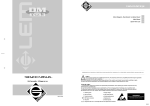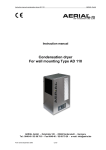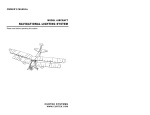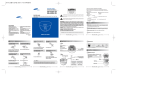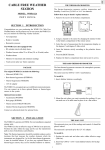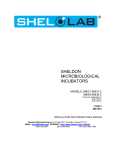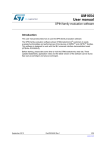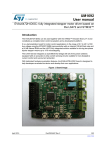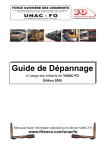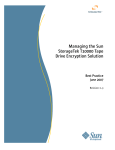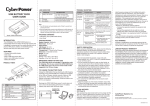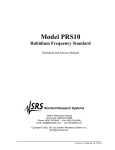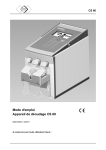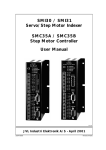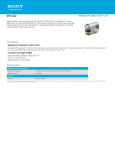Download User Manual
Transcript
SMD41 and SMD42 Step Motor Ministep Drivers User Manual JVL Industri Elektronik A/S LB0043-03GB Updated 10.5.2005 Copyright 1998-2005, JVL Industri Elektronik A/S. All rights reserved. This user manual must not be reproduced in any form without prior written permission of JVL Industri Elektronik A/S. JVL Industri Elektronik A/S reserves the right to make changes to information contained in this manual without prior notice. Similarly JVL Industri Elektronik A/S assumes no liability for printing errors or other omissions or discrepances in this user manual. MotoWare is a registered trademark JVL Industri Elektronik A/S Blokken 42 DK-3460 Birkerød Denmark Tlf. +45 45 82 44 40 Fax. +45 45 82 55 50 e-mail: [email protected] Internet: http://www.jvl.dk Contents 1 1.1 1.2 1.3 1.4 1.5 1.6 1.7 1.8 1.9 1.10 1.11 1.12 1.13 1.14 1.15 1.16 Introduction ................................................................................... 6 Driver Connections ....................................................................... 7 Power Supply ................................................................................. 8 Adjustment of Motor Phase Current ............................................. 9 Connection of Motor ................................................................... 11 Step Pulse and Direction Inputs ................................................... 14 Error Output ................................................................................ 16 Selection of Curve Forms ............................................................ 17 Selection of Step Resolution ......................................................... 18 Physical Dimensions ..................................................................... 19 Technical Specifications ............................................................... 20 Motor Connections ...................................................................... 21 Connection to Indexer SMI30 ...................................................... 23 Connection to PLC / PC Boards .................................................. 24 Accessories .................................................................................. 25 CE Declaration of Conformity ..................................................... 26 JVL Industri Elektronik A/S — User Manual Step Motor Driver SMD41/42 JVL Industri Elektronik A/S — User Manual Step Motor Driver SMD41/42 1 JVL Industri Elektronik A/S — User Manual Step Motor Driver SMD41/42 5 1.1 Introduction Step Motor Driver SMD41/42 is a mini-step driver which has been designed for driving step motors with phase currents of up to 9 Amp/phase (RMS). Driver SMD41/42 is available in 10 different versions for supplying various phase currents and step resolutions up to 25,000 steps per motor revolution. Overview — SMD41/42 Step Motor Driver Series Motor Current per phase Ministeps per full-step 1/2/4/8 10 / 25 / 50 / 125 3Amp/RMS SMD41A3 SMD41A2 6Amp/RMS SMD41/42B3 SMD41/42B2 9Amp/RMS SMD41/42C3 SMD41/42C2 The advantage of using a ministep driver instead of a conventional driver is that mechanical resonance problems are significantly minimised. Resonance most often occurs at slow motor speeds and results either in loss of motor torque or the appearance of significant harmonics. The principle of the ministep technique is to drive the motor using a sinusoidal current in the interval between 2 physical full steps. This reduces the step velocity between each step and thus damps the resonance significantly. A special feature of the SMD41/42 Driver provides a choice of 4 different curve forms to be used for mini-stepping. Theoretically it is correct to control the motor phase current using a sinusoidal current as mentioned above, but in practice however it is often advantageous to drive the motor using a modified sinusoidal curve since there is not always a linear relationship between the current and the motor position. Motor Driver SMD41/42 is built into a black aluminium casing which provides a very robust construction that is insensitive to mechanical vibration. Both 2-phase and 4-phase step motors can be connected to the Driver, which utilises the "Bipolar Chopper" principle of operation, thus giving optimum motor performance. Main Features: • Wide range of power supply: 20-80 VDC (SMD41) or 20-160VDC (SMD42) . • Step frequency up to 800 kHz. • Step Resolution: 200, 400, 800, 1600, 2000, 5000, 10000, 25000 ministeps per motor revolution. • Galvanically isolated Step-pulse and Direction Inputs. • "Power dump" output for sinking overloads. • Automatic switching between Operating and Standby Currents. • Facility for control of Operating and Standby currents via externally applied voltage 0-2.5V or 0-20mA. • Small physical dimensions: 100 x 22 x 114 mm • Error output for temperature overload and short-circuit conditions. • Thermal overload protection. • Filter option for Step-pulse Input. • Compatible with previous model SMD40. 6 JVL Industri Elektronik A/S — User Manual Step Motor Driver SMD41/42 1.2 Driver Connections Scale 1 : 1 Power Error Current Curve 1 Current Curve 2 3 Resolution 4 5 50kHz Filter ON/OFF I 1 I 2 O 3 O4 O 5 O 6 O 7 I 8 I 9 I 10 I 11 I 12 I 13 O 14 SW1 SW2 ON OFF ON OFF ON ON OFF OFF GND / 20..80V=SMD41 Supply 20..160V=SMD42 Motor A + Motor A M Motor B + Motor B Power Dump Direction PNP Stepclock PNP Digital GND Standby Current Move Current Current GND Error A B C D Ministep/Fullstep SW3 SW4 ON OFF ON OFF ON ON OFF OFF Driver Model -1 -2 -3 10 10 10 10 10 25 50 125 1 2 4 8 Model : Stepmotor Ministep Driver Industri Elektronik C JVL Industri Elektronik A/S Made in Denmark Mounting Plate / Heat Sink “Power” Indicator LED “Error” Indicator LED (short-circuit, temperature, etc.) DIP switch for selection of Curve Form DIP switch for selection of Step Resolution DIP switch for selection of Step-pulse Filter on/off Power Supply Input SMD41: 20-80VDC / SMD42: 20-160VDC Motor Output to 2- or 4-phase step motor “Power Dump” Output Step-pulse and Direction Inputs (optically isolated) Input for adjusting Operating and Standby Currents Error Output. Activated by short-circuit or temperature TT0001 JVL Industri Elektronik A/S — User Manual Step Motor Driver SMD41/42 7 1.3 Power Supply Power Error Fuse T10A SMD41 = 20-80VDC SMD42 = 20-160VDC + SMD41 : 33-50 Ohm/50W SMD42 : 68-100 Ohm/50W Warning. If the supply voltage is increased above 95V for SMD41 or 180V for SMD42 it will damage the driver permanent. Current Curve 1 Current Curve 2 3 Resolution 4 5 50kHz Filter ON/OFF I 1 I 2 O 3 O 4 O 5 O 6 O 7 I 8 I 9 I 10 I 11 I 12 I 13 O 14 SW1 SW2 ON OFF ON OFF ON ON OFF OFF GND / 20..80V=SMD41 Supply 20..160V=SMD42 Motor A + Motor A M Motor B + Motor B Power Dump Direction PNP Stepclock PNP Digital GND Standby Current Move Current Current GND Error A B C D Ministep/Fullstep SW3 SW4 Driver Model -1 -2 -3 ON OFF ON OFF 10 10 10 10 ON ON OFF OFF 10 25 50 125 1 2 4 8 Model : Stepmotor Ministep Driver Industri Elektronik C JVL Industri Elektronik A/S Made in Denmark TT0003 1.3.1 Power Supply The power supply for the SMD41/42 is connected to the Driver via terminals 1 and 2. The supply must have an output capacitor of at least 4700µF for optimum operation. To minimise cable induction, this capacitance should not be connected more than 1m from the Driver. 0.75mm cable (minimum) should be used to connect the power supply to the Driver. A T6.3 fuse (SMD41) will do it if you are using 80V and T10A fuse (SMD42) but please keep in mind that it must be a "slow blow" type. The current consumption can be very high during power up since the driver already at 20V try to achieve the selected motor current. The worst case situation is if the driver is setup for full current and is applied with step pulses at the same time during power up. Important!: The SMD41/42 should be protected using a slow-blow fuse of max. 10A since there is no internal fuse. The removable connector must never be removed while power is connected to the SMD41/42 as this will significantly shorten the connector’s lifetime. 1.3.2 Power dump In certain circumstances, the step motor connected to the Driver can induce significant reverse energy surges back to the Driver. This occurs primarily during rapid deceleration of a step motor when large inertial masses are being decelerated. This phenomenon can be problematic since the energy can only be led to the Driver’s power supply capacitor, resulting in a large voltage increase. In situations where the Driver is nominally powered by a voltage of 80VDC (or 160VDC for SMD42), this does not leave any margin for the above-mentioned reverse power surges. In order to solve this problem, the SMD41/42 Driver is equipped with a "safety valve" in the form of terminal 7 (see above illustration). This terminal is connected to a circuit which short-circuits the terminal to ground if the supply voltage exceeds 95VDC (or 180VDC for SMD42). The short circuit is decoupled only when the supply voltage falls below 91VDC(or 168VDC for SMD42). The terminal must be connected to an external resistor, the size of which depends on deceleration parameters. Typically a 3050ohm/50W (or 68-100 Ohm for SMD42) resistor will be suitable. More specific guidelines cannot be given since the actual energy induced depends on motor data, temperature, deceleration rate, etc. 8 JVL Industri Elektronik A/S — User Manual Step Motor Driver SMD41/42 1.4 Adjustment of Motor Phase Current R1 and R2 can be calculated as follows : Amax: The maximum delieverable driver current: 3,6 or 9 Amp.RMS Amp: The required current R1 or R2 = Current Curve 1 Current Curve 2 3 Resolution 4 5 50kHz Filter ON/OFF 50000 x Amp (Amax - Amp) R1 = Standby Current Resistor R2 = Operating Current Resistor R1 Power Error R2 I 1 I 2 O 3 O 4 O 5 O 6 O 7 I 8 I 9 I 10 I 11 I 12 I 13 O 14 SW1 SW2 ON OFF ON OFF ON ON OFF OFF GND / 20..80V=SMD41 Supply 20..160V=SMD42 Motor A + Motor A M Motor B + Motor B Power Dump Direction PNP Stepclock PNP Digital GND Standby Current Move Current Current GND Error Ministep/Fullstep SW3 SW4 A B C D ON OFF ON OFF ON ON OFF OFF Driver Model -1 -2 -3 10 10 10 10 10 25 50 125 1 2 4 8 Model : Stepmotor Ministep Driver Industri Elektronik C JVL Industri Elektronik A/S Made in Denmark TT0004 1.4.1 Adjustment of Motor Phase Current The current supplied to each of the step motor’s phases can be adjusted for standby and operating currents using input terminals 11-13. The values of Standby Current and Operating Current are determined, respectively, by the resistor connected between terminals 11+13 and terminals 12+13. The Driver automatically switches between the two currents by detecting the presence of step-pulses. If a rising edge is detected at the stepclock input the "Move current" is selected. If no rising edges is deteccted for 100mS at the stepclock input the current is automatically switched back to "Standby current". Values for the two currents are typically adjusted so that the Operating Current is significantly higher than the Standby Current, since the motor must be supplied with more power to drive its load during acceleration and constant operation than when it is stationary. Note that the maximum Standby Current can be 50% of the maximum current for the actual driver type. The only overriding consideration that must be made in the adjustment of motor phase currents is that the thermal output of the motor must not exceed the maximum operating temperature of the step motor — see the manufacturer’s product data for the motor in question. Note that terminals 11-13 are not galvanically isolated from other Driver circuitry. The following table indicates the relationship between resistor values and motor phase currents. As illustrated, the motor current is also dependent on the model of the SMD41/42 Driver. Motor Current (Amps RMS per phase) Resistor R1-2 SMD41Ax SMD41/42Bx SMD41/42Cx - 0.00A 0.00A 0.00A 0 Ohm (short-circuit) 0.25A 0.50A 0.75A 4.7kOhm 0.50A 1.00A 1.50A 10kOhm 0.75A 1.50A 2.25A 18kOhm 1.00A 2.00A 3.00A 22kOhm 1.25A 2.50A 3.75A 39kOhm 1.50A 3.00A 4.50A 47kOhm 1.75A 3.50A 5.25A 68kOhm 2.00A 4.00A 6.00A 100kOhm 2.25A 4.50A 6.75A 150kOhm 2.50A 5.00A 7.50A 270kOhm 2.75A 5.50A 8.25A 560kOhm 3.00A (Maximum) 6.00A (Maximum) 9.00A (Maximum) none (open circuit) JVL Industri Elektronik A/S — User Manual Step Motor Driver SMD41/42 9 1.4 Adjustment of Motor Phase Current Current Control Voltage Control Power Error Power Error 1 Current Curve 2 3 Resolution 4 5 50kHz Filter ON/OFF I 1 I 2 O 3 O 4 O 5 O 6 O 7 I 8 I 9 I 10 I 11 I 12 I 13 O 14 Operating Current 120 Ohm Standby Current 1.4.2 GND / Supply Motor A + Motor A Motor B + Motor B Power Dump Direction PNP Stepclock PNP Digital GND Standby Current Move Current Current GND Error 1 Current Curve 2 3 Resolution 4 5 50kHz Filter ON/OFF + I 1 I 2 O 3 O 4 O 5 O 6 O 7 I 8 I 9 I 10 I 11 I 12 I 13 O 14 + Standby Current GND / Supply Motor A + Motor A Motor B + Motor B Power Dump Direction PNP Stepclock PNP Digital GND Standby Current Move Current Current GND Error Operating Current TT0012GB Motor Current Controlled by Voltage or Current In cases where current control is not desired via an external resistor, but via an externally applied voltage, terminals 11-13 can also be used. A voltage in the range 0 to 2.50VDC should be applied to the two terminals, corresponding to motor currents of 0 to 3Amp for SMD41Ax, 0 to 6 Amp for SMD41/42Bx, and 0 to 9 Amp for SMD41/42Cx. If current control of the motor phase current using a standard signal in the range 0-20mA is required, a 127 Ohm/1%(E48) or 120 Ohm/5%(E24) resistor should be connected between "Current GND" and each input — see above illustration. The relationship between the voltage at the terminals and the motor current is liniar from 0 to full-scale. 10 JVL Industri Elektronik A/S — User Manual Step Motor Driver SMD41/42 1.5 Connection of Motor Power Error 1 Current Curve 2 3 Resolution 4 5 50kHz Filter ON/OFF Terminate screen only for driver Ground Shield I 1 I 2 O 3 O 4 O 5 O 6 O 7 I 8 I 9 I 10 I 11 I 12 I 13 O 14 GND / Supply Motor A + Motor A Motor B + Motor B Power Dump Direction PNP Stepclock PNP Digital GND Standby Current Move Current Current GND Error TT0016GB 1.5.1 Cabling For Driver models that supply a phase current in the range 0 to 6 A, it is recommended that 0.75mm² cable (minimum) is used to connect the motor to the Driver. For Driver models that supply a phase current in the range 0 to 9 A, it is recommended that 1.5mm² cable is used to connect the motor to the Driver. Cable lengths used to connect the motor to the Driver should not exceed 10 metres because of impedance loss. Connected cables should be securely tightened since a poor connection can cause heating and destruction of the connector terminals. Similarly, tinned conductors should be avoided. The torque used for each screw is recommended in the range 0.22 - 0.25Nm. Important! To minimise spurious noise emission from the motor cables and fulfil CE requirements, screened cable must be used! If screened cable is not used, other electronic equipment in the vicinity may be adversely affected. The removable connector must never be removed while a voltage is connected as this will significantly reduce the lifetime of the connector. Note also that the connector’s lifetime is reduced by repeated connecting/disconnecting since the contact resistance of the pins is increased. Note that GND (1) is connected to the chassis and functions as the main ground on the SMD41/42. See also Motor Connections, page 21, which describes how various models of motor should be connected to the SMD41/42. JVL Industri Elektronik A/S — User Manual Step Motor Driver SMD41/42 11 1.5 Connection of Motor Serial connection of phases: Motor Torque Driver Parallel Serial Velocity Current for Serial or Parallel connection Parallel connection of phases: Driver Motor 4-phase parallel Motor 4-phase serial Maximum current settting Example motor 4.2A I x 1.41 4.2 x 1.41 =5.9 1.41 Motor 2-phase 4.2 = 3A 1.41 4.2A I = Nominal current per phase in accordance with manufacturer's specifications 1.5.2 TT0008 Connection of Step Motor Various types of step motor are available: 1. 2-phase Bipolar (4 cables) 2. 4-phase Bipolar/Unipolar (8 cables) 3. 4-phase Unipolar (6 cables). Not suitable. Note that Type 3 motors indicated above (Unipolar motors) are not suitable for operation with this series of Drivers since the Drivers utilise the bipolar principle. Note that a bipolar system typically yields 40% greater torque than unipolar systems. 2-phase or 4-phase motors can be connected to the Drivers as follows: 2-phase Motors (4 cables). This type of motor can be directly connected to the Driver’s output terminals. The Driver current adjustment must not exceed the manufacturer’s specified rated current for the motor. 4-phase Motors (8 cables). This type of motor can be connected to the Driver in one of the 2 following ways: 1. Serial connection of phases. 2. Parallel connection of phases. Selection of serial or parallel connection of the motor phases is typically determined by the speed requirements of the actual system. If slow speeds are required (typically less than 1 kHz), the motor phases can be connected in serial. For operation at higher speeds (greater than 1 kHz), the motor phases can be connected in parallel. 12 JVL Industri Elektronik A/S — User Manual Step Motor Driver SMD41/42 1.5 Connection of Motor Serial Connection: Using serial connection of the phases, a motor provides the same performance (up to 1kHz) as parallel connection, but using only approximately half the current. This can influence the selection of Driver model and enables a Driver rated for a lower motor current to be used. See illustration on previous page. If the phases of a 4-phase step motor are connected in series, the motor’s rated phase current should be divided by 1.41. For example, if the rated current is 4.2A, the maximum setting of the Driver phase current must not exceed 3 A when the motor phases are connected in series. Parallel Connection: With parallel connection of motor phases, a motor will provide better performance at frequencies greater than 1kHz compared to serially connected phases, but requires approximately twice the current. This can influence the choice of Driver since it is necessary to select a Driver that can supply twice the current used for serial phase connection. See illustration on previous page. When the phases of a 4-phase motor are connected in parallel, the specified rated current of the motor must be multiplied by a factor of 1.41. For example, if the rated current is 4.2 A, the maximum setting of the Driver phase current must not exceed 5.9 A when the phases are connected in parallel. It should be noted that the lower the self-induction of the motor the better since this influences the torque at high speeds. The torque is proportional to the current supplied to the motor. The applied voltage is regulated by the Driver so that the phase current is adjusted to the selected value. In practice this means that if a motor with a large self-inductance (e.g. 100mH) is used, the Driver cannot supply the required phase current at high speeds (high rotational frequencies) since the output voltage is limited. JVL Industri Elektronik A/S — User Manual Step Motor Driver SMD41/42 13 1.6 Step Pulse and Direction Inputs Step occurs on the leading flank Step clock (P9) Min. 500nS 1 0 Min. 2.5µS Direction (P8) PLC or Pulse Generator Direction Output Pulse Output Ground PNP Outputs Min. 500nS Power Error Min. 2.5µS 1 Current Curve 2 3 Resolution 4 5 50kHz Filter ON/OFF 1 0 The Direction signal must be well defined in this interval Screen Note ! : screen only connected on signal source. I 1 I 2 O 3 O4 O 5 O 6 O 7 I 8 I 9 I 10 I 11 I 12 I 13 O 14 GND / Supply Motor A + Motor A Motor B + Motor B Power Dump Direction PNP Stepclock PNP Digital GND Standby Current Move Current Current GND Error TT0010 1.6.1 Step Pulse and Direction Inputs The 2 main inputs on the SMD41/42 are the Step Pulse and Direction Inputs shown in the above illustration. The Step Pulse Input is used for applying pulse signals which make the motor move. One signal pulse corresponds to a single ministep. The Direction Input determines the direction of the motor movement. If logic "1" is applied to the Direction Input, the motor moves forward. If logic "0" is applied to the Input, the motor moves backwards. Both the Step Pulse and Direction Inputs are optically isolated from other Driver circuitry and must be driven either by a push-pull driver or a PNP (source) driver. The Inputs can handle voltages in the range 0 to 30 V, which makes the SMD41/42 well suited for industrial applications, for example in PLC systems. Optical isolation of the Inputs ensures that the SMD41/42 is not affected by extraneous electrical noise. Both Inputs are partly current driven, which also contributes to the Driver’s noise immunity, particularly if the signal source is located at a distance from the Driver. It is, however, recommended that screened cable is always used for connection to the Step Pulse and Direction Inputs. Both inputs must be controlled from a "Source-driver". This means that they share a common ground — see above illustration. The Driver executes the step on the leading flank of the Step Input pulse — see above illustration. 1.6.2 14 Input Filter In situations where the step-pulse signal’s rise and fall time is very slow - > 1 µS, it is recommended that the built-in Input Filter is used. The Filter is enabled by setting DIP switch 5 to the "ON" position. This limits the bandwidth of the Step Pulse Input to <50kHz. Note that the pulse width must be > 10 µS if the Input Filter is used. JVL Industri Elektronik A/S — User Manual Step Motor Driver SMD41/42 1.6 Step Pulse and Direction Inputs This diagram should be used if a PNP output is to be connected Input Circuitry on the SMD41 and 42 PC410 PNP Output + 5-30VDC Direction P8 To "Direction" or "Stepclock" Pulse source 1,5kOhm 470pF To "Digital GND" This diagram should be used if an NPN output is to be connected Stepclock P9 100pF + Pulse source R NPN Output To "Direction" or "Stepclock" 100nF To "Digital GND" 1.6.3 Digital GND P10 PC410 Chassis TT0011 Signal Source with NPN Output Normally the output circuit of the signal source is regarded as a PNP output to comply with European Standard. However there are a number of PLC controllers or PC axis boards that use an NPN output. To connect these NPN systems to the SMD41/42, a "pull up" resistor must be used, as shown in the above illustration. The size of the resistor depends on the actual signal source used. Use the following table to determine the required resistance. Voltage Resistance (R) 5-8VDC 470 Ohm 8-14VDC 1.5 kOhm 14-20VDC 2.2 kOhm 20-30VDC 2.7 kOhm It is recommended that a resistor type SFR25 (0.5W) or SFR16 (0.3W) is used. 1.6.4 Input Circuitry As shown in the above illustration, the Driver’s input circuitry is galvanically isolated from other circuits. This prevents ground loops that could cause unwanted errors in the step pulse and direction signals. Note that the Inputs’ ground (Digital GND) is also used for the Error Output P14. JVL Industri Elektronik A/S — User Manual Step Motor Driver SMD41/42 15 1.7 Error Output Power Error Normal operation Error (P14) PLC 1 Current Curve 2 3 Resolution 4 5 50kHz Filter ON/OFF Error 1 I 1 I 2 O 3 O 4 O 5 O 6 O 7 I 8 I 9 I 10 I 11 I 12 I 13 O 14 0 + + Ground Input GND / Supply Motor A + Motor A Motor B + Motor B Power Dump Direction PNP Stepclock PNP Digital GND Standby Current Move Current Current GND Error TT0013GB 1.7.1 Error Output The Driver’s Error Output enables a PLC or other equipment in a motion control system to verify that the Driver is functioning correctly. Under normal operation the Error Output has a status of logic "1", but if the Driver is short-circuited or the temperature exceeds 85 degrees Centigrade, the Output is switched to logic "0". Note that the Output is of the NPN type and must therefore have a "Pull up" resistor connected to the actual supply (0-30VDC). For a PLC system operating with 24V levels, a 2.2kOhm resistor will typically be required. This relatively low resistance is necessary to maintain a current of 10mA, which is typically required for a PLC input to be activated. For 5V logic inputs, a resistance of 1kOhm is recommended. Note that the Error Output has a maximum rated loading of 50mA and is not short-circuit protected! 16 JVL Industri Elektronik A/S — User Manual Step Motor Driver SMD41/42 1.8 Selection of Curve Forms Selection of curve form Power Error Current Curve 1 Current Curve 2 3 Resolution 4 5 50kHz Filter ON/OFF I 1 I 2 O 3 O 4 O 5 O 6 O 7 I 8 I 9 I 10 I 11 I 12 I 13 O 14 SW1 SW2 ON OFF ON OFF ON ON OFF OFF GND / 20..80V=SMD41 Supply 20..160V=SMD42 Motor A + Motor A M Motor B + Motor B Power Dump Direction PNP Stepclock PNP Digital GND Standby Current Move Current Current GND Error A B C D Ministep/Fullstep SW3 SW4 Driver Model -1 -2 -3 ON OFF ON OFF ON ON OFF OFF 10 10 10 10 10 25 50 125 1 2 4 8 Model : Stepmotor Ministep Driver Industri Elektronik C JVL Industri Elektronik A/S Made in Denmark TT0014 1.8.1 Selection of Curve Forms The mini steps normally use a sinusoidal curve to drive the motor. For some types of step motor, the relationship between current and the step motor’s position is not completely linear. In such cases, it is possible to modify the sinusoidal curve and thus achieve better and more precise positioning of the motor. Using 2 DIP switches on the Driver (see above illustration), it is possible to operate the motor using 1 of 4 different curve forms: ideal sinusoidal curve, sine + 3%, sine + 6% or sine - 3%. The DIP switch settings are given below: DIP-switch settings Curve form ON ON Curve A - Ideal sine OFF ON Curve B - Sine +3% ON OFF Curve C - Sine +6% OFF OFF Curve D - Sine -3% Contact JVL if external control of the selection of the curve form is required. JVL Industri Elektronik A/S — User Manual Step Motor Driver SMD41/42 17 1.9 Selection of Step Resolution Power Error Step resolution Current Curve 1 Current Curve 2 3 Resolution 4 5 50kHz Filter ON/OFF I 1 I 2 O 3 O 4 O 5 O 6 O 7 I 8 I 9 I 10 I 11 I 12 I 13 O 14 SW1 SW2 ON OFF ON OFF ON ON OFF OFF GND / 20..80V=SMD41 Supply 20..160V=SMD42 Motor A + Motor A M Motor B + Motor B Power Dump Direction PNP Stepclock PNP Digital GND Standby Current Move Current Current GND Error A B C D Ministep/Fullstep SW3 SW4 Driver Model -1 -2 -3 ON OFF ON OFF 10 10 10 10 ON ON OFF OFF 10 25 50 125 1 2 4 8 Model : Stepmotor Ministep Driver Industri Elektronik C JVL Industri Elektronik A/S Made in Denmark TT0015GB 1.9.1 Step Resolution The SMD41/42 series comprises 3 different step resolution groups. SMD41/42x3 has the lowest resolution and SMD41/42x2 has the greatest. The following table shows the step resolutions that are available. The values "per revolution" are based on a standard motor with 200 steps per revolution. Type Mini steps/full step Mini steps/revolution SMD41/42x2 10, 25, 50, 125 2000, 5000, 10000, 25000 SMD41/42x3 1, 2, 4, 8 200, 400, 800, 1600 For Driver models SMD41/42x2 and SMD41/42x3, the ministep resolution can be adjusted using 2 DIP switches on the side panel of the Driver — see above illustration. Use of higher step resolution minimises mechanical resonances and thus provides optimum motor torque throughout the entire range of velocity. Note that the motor’s resonances/torque is also heavily determined by the supply voltage. At high supply voltages, optimum torque is achieved at high rates of revolution. Contact JVL if control of step resolution from an external unit is required. 18 JVL Industri Elektronik A/S — User Manual Step Motor Driver SMD41/42 97.0 r2,5 109.0 Ø5 3.0 I 1 I 2 O3 O4 O5 O6 O7 I 8 I 9 I 10 I 11 I 12 I 13 O14 A B C D 1 2 4 8 C Made in Denmark JVL Industri Elektronik A/S Industri Elektronik Stepmotor Ministep Driver 10 25 50 125 10 10 10 10 ON OFF ON OFF ON ON OFF OFF Driver Model -1 -2 -3 Ministep/Fullstep SW3 SW4 Model : ON ON OFF OFF ON OFF ON OFF GND / 20..80V=SMD41 Supply 20..160V=SMD42 Motor A + Motor A M Motor B + Motor B Power Dump Direction PNP Stepclock PNP Digital GND Standby Current Move Current Current GND Error SW2 SW1 100.0mm 4.0 TT0003 r2,5 1 Current Curve 2 3 Resolution 4 5 50kHz Filter ON/OFF 57.0 Current Curve r2,5 Error 17.0 Power 1.10 Physical Dimensions 8 0 5 114.0 mm 4.3 22.0mm 10.5 All dimensions in mm Tolerance +/- 0.1 mm TT0009 JVL Industri Elektronik A/S — User Manual Step Motor Driver SMD41/42 19 1.11 Technical Specifications Minimum Typical Maximum Absolute maximum Units 80 90 VDC Power Supply: SMD41 : Supply Voltage - nominal 20 SMD42 : Supply Voltage - nominal 20 Current Consumption, without motor 35 @80V 67 @40V 160 70 VDC 170 @20V - mADC Driver Stage: Chopper Frequency 20 24 - kHz Motor Current (per phase) 0.0 (3, 6, 9)* - A RMS - Watt 2 - ADC 0 90 (180) 100 (200) VDC Voltage Logic "1" 4.3 28 32 VDC Voltage Logic "0" 0 3.0 - VDC Current Logic "1" 8 12 - mADC Current Logic "0" (open) 0 3 Pulse Duration - Logic "1" 500 Pulse Duration - Logic "0" 500 Power Loss in Driver (Watt per A RMS) 1.5 "Power Dump" Output: Continuous Current Voltage SMD41(42) Step Pulse Input: Rise Time 100 Decay Time - mADC - ns - ns - ns 100 - ns Frequency 0 800 - kHz Frequency (with Step Filter - DIP 5) 0 50 - kHz Voltage Logic "1" 4.3 28 32 VDC Voltage Logic "0" 0 3 - VDC Current Logic "1" (source) 10 20 - mADC Current Logic "0" (open) 0 3 - mADC - kOhm Direction Input: Current Control Inputs: Input Impedance 50 Input Voltage 0 2.50 5.0 VDC -20 45 - °C - °C 95 - % Diverse: Temperature range (ambient) Temperature alarm (internal temp.) 85 Humidity 0 Weight - 250 - - gram Recommended Heat Sink Data SMD41Ax 0 - - - K/W Recommended Heat Sink Data SMD41Bx 2 1 - - K/W Recommended Heat Sink Data SMD41Cx 1 0.6 - - K/W Recommended Heat Sink Data SMD42Bx 1 - - - K/W Recommended Heat Sink Data SMD42Cx 0.6 - - - K/W * SMD41Ax - 3A RMS /SMD41/42Bx - 6A RMS/ SMD41/42Cx - 9A RMS 20 JVL Industri Elektronik A/S — User Manual Step Motor Driver SMD41/42 1.12 Motor Connections Connection of JVL and MAE 4 wire motors. Type MST17x and HY200-xxxx-xxx-x4 Connection of JVL and MAE motors (parallel). Type MST23x/ MST34x and HY200-xxxx-xxx-x8 Black AB+ B- Black / White Orange / White A+ Black A Red B A B Red / White AB+ B- A B Yellow Black/White Orange/White Orange Red BYellow A+ A B A Driver A+ Driver (Blue 17xx) Connection of Zebotronics motor Type : SMxxx.x.xx.x (8 terminals) Black B+ (Red 17xx) Red Yellow / White Yellow Connection of JVL and MAE motors (serial). Type MST23x/ MST34x and HY200-xxxx-xxx-x8 A- (White 17xx) Orange (Yellow 17xx) Orange Driver Driver A+ B Red/White Yellow/White AB+ B- 1 Brown 3 2 Black White 4 Red 5 Blue 7 Yellow 6 8 Gray Green SM87/SM107/168.x.xx Connection of MAE motor (unipol.) Type HY200-1xxx-xxxxx6 A A B B SM56.x.xx Connection of Zebotronics motor Type : SMxxx.x.xx.x (4 terminals) ( Motor in unipolar model - 6 wires ) AB+ B- White Green Black Red A+ A A B B White/ Green White/ Red Driver Driver A+ AB+ B- Black 1 Green 2 Red 3 A B White 4 TT0005 JVL Industri Elektronik A/S — User Manual Step Motor Driver SMD41/42 21 1.12 Motor Connections Connection of Vexta motor Type PH2xx.xxx Connection of Phytron motor Type ZSx.xxx.x,x Red ( Motor in unipolar model - 6 cables ) AB+ B- Yellow Red A+ A A B B White Driver Driver A+ Black AB+ B- Brown Black Yellow Blue A A B B Violet White Green Connection of Vexta stepmotor Type : PH2xx-xxx Driver A+ AB+ B- Black Black / White Orange / White Orange Red A A B B Red / White Yellow / White Yellow TT0006 22 JVL Industri Elektronik A/S — User Manual Step Motor Driver SMD41/42 1.13 Connection to Indexer SMI30 A power-dump resistor may be mounted (SMD41 : 33-50 Ohm/50W) (SMD42 : 68-100 Ohm/50W) u POWER PROGRAM MOTOR ERROR Fuse T10A HM PL NL I I8 I7 I6 I5 I I4 I3 I2 I1 RS232 RS485 I P+ PAI1 AI2 AO1 A B OE O+ O1 DRIVER O2 O3 O4 O5 O6 O7 O8 O- SMD41 : 20-80VDC SMD42 : 20-160VDC 1 Current Curve 2 3 Resolution 4 5 50kHz Filter ON/OFF + Motor Ground Screen Screen connected to digital GND as close to driver as possible SMI30 / 31 1.13.1 I 1 I 2 O 3 O 4 O 5 O 6 O 7 I 8 I 9 I 10 I 11 I 12 I 13 O 14 GND / Supply Motor A + Motor A Motor B + Motor B Power Dump Direction PNP Stepclock PNP Digital GND Standby Current Move Current Current GND Error TT0017 Screen DRIVER 2,2k Power Error P+ SALA COIN SON 6 7 8 9 1 2 3 4 5 Resistor values selected in accordance with table in section "Adjustment of Motor Current” CLKCLK+ DIRDIR+ GND Connection to Indexer SMI30 The above illustration shows how a typical connection is made between the SMD41/42 and JVL Indexer SMI30 or SMI31. It is recommended that screened cable is used for connecting the motor and the logic signals to the SMI3x in order to avoid spurious noise problems and to fulfil the requirements of CE conformity for the complete system. It is recommended that the cable length between the SMI3x and SMD41/42 does not exceed 2 m. The following SMI3x registers must be set: PR Pulses per motor revolution. This register must be set according to the number of steps per revolution selected on the SMD41/42. CB15Control flag for SALA (servo alarm). This flag is set to CB15=1 so that the SMI3x accepts logic 0 as the active level for the SALA input. This means that the SMI3x detects any error from the SMD41/42 when the "Error" Output goes to logic 0. JVL Industri Elektronik A/S — User Manual Step Motor Driver SMD41/42 23 Connection to PLC / PC Boards + 8 24VDC 10 9 Stepclock Direction 8 + 24VDC 10 Digital GND Stepclock Direction Driver 9 Driver 1.14 Digital GND Aux.12V Direction + 24VDC 10 Digital GND Pulse 9 Direction 8 5-12VDC + Aux.GND 10 Stepclock Direction Driver 8 Stepclock Driver 9 Digital GND TT0007 24 JVL Industri Elektronik A/S — User Manual Step Motor Driver SMD41/42 1.15 Accessories The following accessories are available for use with the SMD41/42. MM3101 Heat Sink Plate 100 x 160 x 15 mm. Thermal resistance 1K/W. The Heat Sink Plate is ready for mounting in a 19" rack. Screws for mounting the SMD41/ 42 are included. MM3101 is suitable for all models of the SMD41/42. MM3103 Heat Sink Plate 100 x 114 x 67.5 mm. Thermal resistance better than 0.6K/W. The Heat Sink Plate is ready for "wall" mounting. Screws for mounting the SMD41/42 are included. MM3103 is suitable for all models of the SMD41/42. Heatsink for 19” rack mounting type MM3101 Heatsink for “wall” mounting type MM3103 TT0019 RP0001 Power dump resistor 33 Ohm/50W. Dimensions: 16x50x16mm excluding connection terminals and mounting flanges. CS0002 14-pole Connector. This connector is always mounted on the SMD41/42 on delivery and is standard. If the connector is lost or becomes damaged, a new one can be ordered using this number. SMI30 Step Motor Indexer. The SMI30 is a programmable Indexer which can be used as a standalone unit for executing user programs for motor control using positioning and various speeds. The SMI30 is based on a motor processor that can generate step pulse frequencies up to 2MHz. See Connection to Indexer SMI30, page 23, for further details. Cables JVL can supply customised cables for specific applications. Contact JVL for further information. JVL Industri Elektronik A/S — User Manual Step Motor Driver SMD41/42 25 1.16 CE Declaration of Conformity EU - Declaration of Conformity We hereby declare that the followiing eqipment fulfils the protection requirements of Council Directive 89/336/EEC on electromagnetic compatibility (EMC). Identification of equipment Category: Motor Controller Manufacture:JVL Industri Elektronik A/S Type: SMD41A/B/C, 1/2/3 Step Motor Ministep Driver SMD42A/B/C, 1/2/3 Step Motor Ministep Driver Manufacturer’s Data: JVL Industri Elektronik A/S Blokken 42 DK-3460 Birkerød Tlf. +45 45 82 44 40 Fax. +45 45 82 55 50 E-mail: [email protected] Internet: http://www.jvl.dk The following standards have been used as the basis for this declaration: Emission - EN50081-2 1993 Immunity - EN50082-2 1994 Notes: The CE-mark only imdicates conformity with EMC-direktive 89/336/EEC Date 1st.January 1999 Bo V. Jessen Technical Director TT0018 Revideret 14.2.1996 26 JVL Industri Elektronik A/S — User Manual Step Motor Driver SMD41/42 1.18 Index A Accessories 25 Adjustment of Step Resolution 18 B Bandwidth of Step Pulse Input 14 Bipolar motors 12 I S Indexer SMI30 or SMI31 23, 25 Input circuitry 15 Input Filter 14 Introduction 6 Cabling 11, 23, 25 CB15 register (SMI3x Indexer) 23 CE requirements 11, 26 Chopper frequency 20 Connection of motor 12–13 Connection of motor phases 13 Connections, Overview 7 Connector 25 CS0002 4-pole connector 25 Current Control Inputs 20 Current control of motor current 10 Curves Forms, Selection of 17 16 M Ministeps 6, 18 MM3101 Heat Sink Plate 25 C Motor Connection 13, 21–22 Motor current 20 12– Adjustment of 9 control via external voltage or current 10 Motor Phases 12 Decay time 14, 20 Declaration of Conformity 26 Dimensions 19 DIP switches 14, 17–18 Direction Input 14, 20 E Error Output 16 F Features 6 Filter, SMD41 Input Filter 14 8 23, 25 Specifications 20 Standby Current 9 Step Pulse Input 14, Step Resolution 18 20 T Technical Specifications Temperature protection 11 O Operating Current 9 Optical isolation 14 Overview of the SMD41 Driver Series 6 P D Sinusoidal wave forms 17 SMD40 6 SMD41 Overview 6 SMI30, SMI31 Indexers 20 N Noise 11, 14 Noise emission NPN 15–16 SALA (servo alarm) 23 Screened cable 11, 23 Serial connection of motor phases 12–13 Short-circuit protection Parallel connection of motor phases 12–13 PC Boards 24 Phase Current, Adjustment of Motor Phase Current 9 Phases 12 Physical Dimensions 19 PLC systems 16, 24 PNP 14 Power Dump 8, 20, 25 Power Loss 20 Power Supply 8, 20 Pulse duration 14, 20 Pulses 14 16 Temperature Range Torque 13 20 U Unipolar Motors 12 V Voltage control of motor current 10 W Weight 20 Fuse R G Galvanic isolation H Heat Sink 20, Humidity 20 25 14 Registers, SMI3x 23 Resonances 6, 18 Rise time 14, 20 RP0001 Power Dump Resistor 25 JVL Industri Elektronik A/S — User Manual Step Motor Driver SMD41/42 27



























